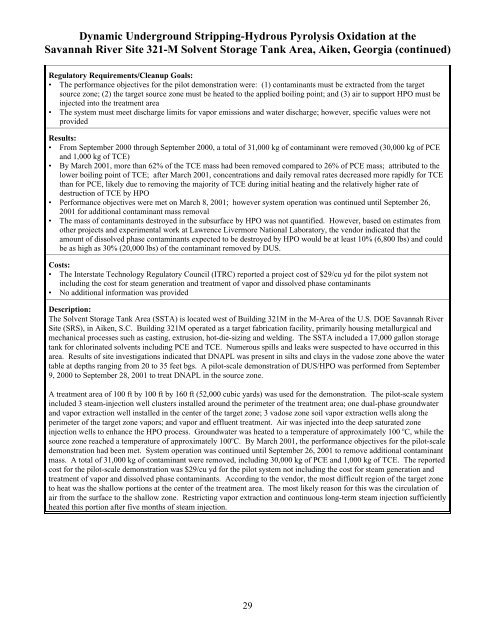Abstracts of Remediation Case Studies, Volume 7 - Federal ...
Abstracts of Remediation Case Studies, Volume 7 - Federal ...
Abstracts of Remediation Case Studies, Volume 7 - Federal ...
You also want an ePaper? Increase the reach of your titles
YUMPU automatically turns print PDFs into web optimized ePapers that Google loves.
Dynamic Underground Stripping-Hydrous Pyrolysis Oxidation at the<br />
Savannah River Site 321-M Solvent Storage Tank Area, Aiken, Georgia (continued)<br />
Regulatory Requirements/Cleanup Goals:<br />
The performance objectives for the pilot demonstration were: (1) contaminants must be extracted from the target<br />
source zone; (2) the target source zone must be heated to the applied boiling point; and (3) air to support HPO must be<br />
injected into the treatment area<br />
The system must meet discharge limits for vapor emissions and water discharge; however, specific values were not<br />
provided<br />
Results:<br />
From September 2000 through September 2000, a total <strong>of</strong> 31,000 kg <strong>of</strong> contaminant were removed (30,000 kg <strong>of</strong> PCE<br />
and 1,000 kg <strong>of</strong> TCE)<br />
By March 2001, more than 62% <strong>of</strong> the TCE mass had been removed compared to 26% <strong>of</strong> PCE mass; attributed to the<br />
lower boiling point <strong>of</strong> TCE; after March 2001, concentrations and daily removal rates decreased more rapidly for TCE<br />
than for PCE, likely due to removing the majority <strong>of</strong> TCE during initial heating and the relatively higher rate <strong>of</strong><br />
destruction <strong>of</strong> TCE by HPO<br />
Performance objectives were met on March 8, 2001; however system operation was continued until September 26,<br />
2001 for additional contaminant mass removal<br />
The mass <strong>of</strong> contaminants destroyed in the subsurface by HPO was not quantified. However, based on estimates from<br />
other projects and experimental work at Lawrence Livermore National Laboratory, the vendor indicated that the<br />
amount <strong>of</strong> dissolved phase contaminants expected to be destroyed by HPO would be at least 10% (6,800 lbs) and could<br />
be as high as 30% (20,000 lbs) <strong>of</strong> the contaminant removed by DUS.<br />
Costs:<br />
The Interstate Technology Regulatory Council (ITRC) reported a project cost <strong>of</strong> $29/cu yd for the pilot system not<br />
including the cost for steam generation and treatment <strong>of</strong> vapor and dissolved phase contaminants<br />
No additional information was provided<br />
Description:<br />
The Solvent Storage Tank Area (SSTA) is located west <strong>of</strong> Building 321M in the M-Area <strong>of</strong> the U.S. DOE Savannah River<br />
Site (SRS), in Aiken, S.C. Building 321M operated as a target fabrication facility, primarily housing metallurgical and<br />
mechanical processes such as casting, extrusion, hot-die-sizing and welding. The SSTA included a 17,000 gallon storage<br />
tank for chlorinated solvents including PCE and TCE. Numerous spills and leaks were suspected to have occurred in this<br />
area. Results <strong>of</strong> site investigations indicated that DNAPL was present in silts and clays in the vadose zone above the water<br />
table at depths ranging from 20 to 35 feet bgs. A pilot-scale demonstration <strong>of</strong> DUS/HPO was performed from September<br />
9, 2000 to September 28, 2001 to treat DNAPL in the source zone.<br />
A treatment area <strong>of</strong> 100 ft by 100 ft by 160 ft (52,000 cubic yards) was used for the demonstration. The pilot-scale system<br />
included 3 steam-injection well clusters installed around the perimeter <strong>of</strong> the treatment area; one dual-phase groundwater<br />
and vapor extraction well installed in the center <strong>of</strong> the target zone; 3 vadose zone soil vapor extraction wells along the<br />
perimeter <strong>of</strong> the target zone vapors; and vapor and effluent treatment. Air was injected into the deep saturated zone<br />
injection wells to enhance the HPO process. Groundwater was heated to a temperature <strong>of</strong> approximately 100 o C, while the<br />
source zone reached a temperature <strong>of</strong> approximately 100 o C. By March 2001, the performance objectives for the pilot-scale<br />
demonstration had been met. System operation was continued until September 26, 2001 to remove additional contaminant<br />
mass. A total <strong>of</strong> 31,000 kg <strong>of</strong> contaminant were removed, including 30,000 kg <strong>of</strong> PCE and 1,000 kg <strong>of</strong> TCE. The reported<br />
cost for the pilot-scale demonstration was $29/cu yd for the pilot system not including the cost for steam generation and<br />
treatment <strong>of</strong> vapor and dissolved phase contaminants. According to the vendor, the most difficult region <strong>of</strong> the target zone<br />
to heat was the shallow portions at the center <strong>of</strong> the treatment area. The most likely reason for this was the circulation <strong>of</strong><br />
air from the surface to the shallow zone. Restricting vapor extraction and continuous long-term steam injection sufficiently<br />
heated this portion after five months <strong>of</strong> steam injection.<br />
29
















